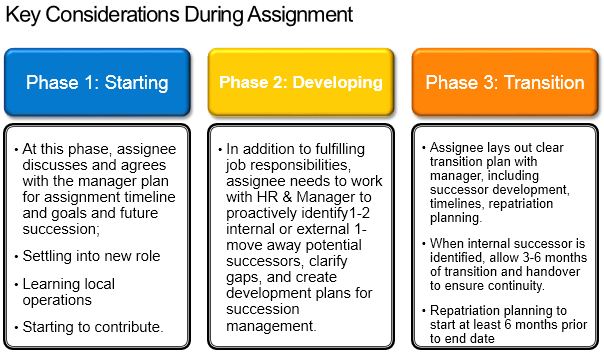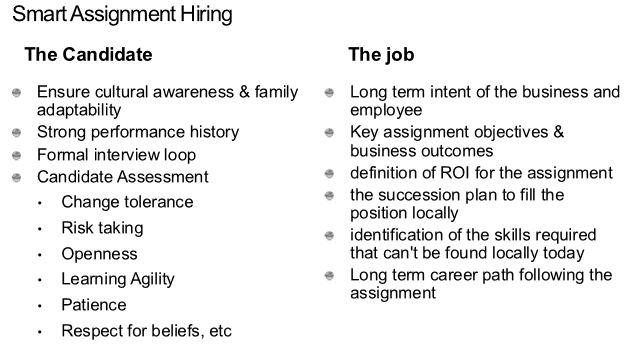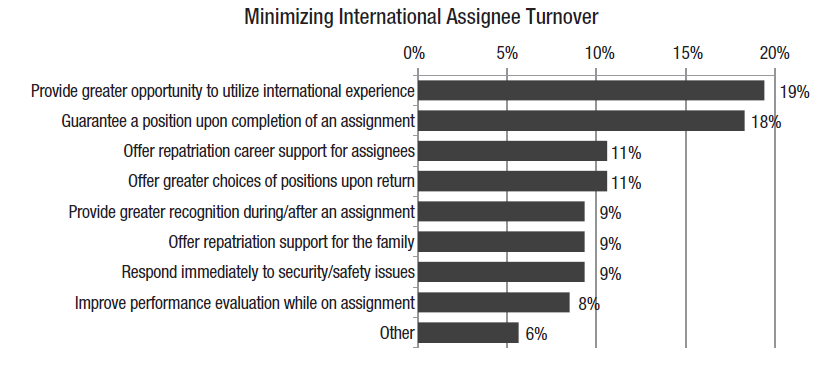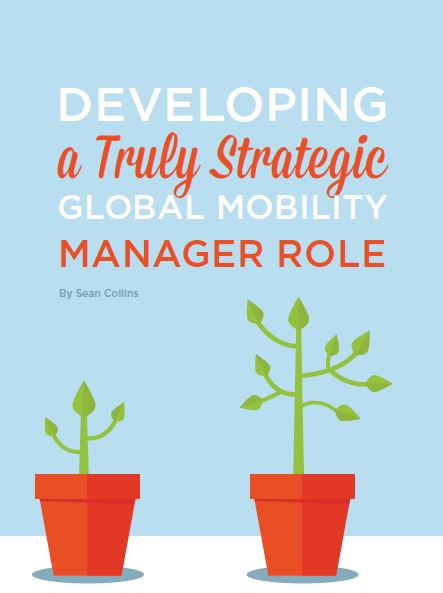In part two of this talent management series I dive deeper into actual talent management strategies that will help drive ROI throughout the international assignment process. I have split this into 3 main milestones in the assignment lifecycle – hiring, on assignment and repatriation
1. HIRING
This is one of the most critical stages impacting the success of the assignment. At this stage the truly strategic global mobility manager needs to be asking the right consultative questions to ensure the business and HR are considering the right talent for the role, i.e. what are the key skills and competencies required and are these available locally? Do we have the best candidates applying for this role? Have we tapped into the global talent pipeline? Is there anyone within country or region that can do the role? A formal interview loop should always be used, as with any hire, to ensure objective decisions are being made for such a significant investment, and will reduce the risk of a manager trying to bring in “his or her own”
Once a candidate has been identified with the right technical skills and competencies, a further candidate assessment should be performed to determine the right cultural and family fit. Key factors of assignment success include familial factors, support systems, stress and change tolerance, self-insight, adaptability and relational skills – all affected by cultural differences. A multitude of off the shelf candidate assessment tools can be used for this purpose and can also be made available online on the company intranet so potential employees looking for international roles can assess their suitability and potential challenges.
Once the candidate has been selected it will be important to set the agenda for the assignment and set expectations with the employee, including upfront communication on the assignment timeline, career development and/or localization path. Global Mobility will need to be asking the following type of questions to ensure the assignment has clear objectives and priorities:
- What are the key priorities for this assignment? What key competencies match to these priorities?
- Looking out 6 months – 1 year, what would a successful person have accomplished? How will it be measured?
- What experiences will be gained by this assignment, and how do they help the candidate build his/her career trajectory?
- Who will sponsor the assignment to help ensure a successful return after the assignment?
I have summarized the above advice in a simple table below called Smart Assignment Hiring outlining key points to consider on both the candidate and the job side
Approval Process: Having a robust and disciplined approval process for international assignments will help drive the right hiring and investment decisions. A standardized approval format should always include a detailed cost estimate of the assignment so that decision makers can understand the investment the business is making (especially relevant for project assignments). It should also outline the drivers for the assignment, summary of interview notes, details of the attempts to hire locally and identification of the specific skill sets not available in the local labour market (this will also highlight local talent development needs). For developmental assignments a clear career development plan should be outlined with timelines and potential roles post assignment. To help drive consistency and ensure thoughtful business justification the approval document can include consultative questions as outlined above. HR would typically drive the approval process along with the hiring manager, seeking the approval typically from the relevant business and HR lead (the higher up the org the better). Host country HR should be looped in from the start so that they have the ability to highlight local talent alternatives and ensure the assignment objectives align with the local business goals.
2. ON ASSIGNMENT
Sponsor: Companies that have integrated talent management into their mobility program would typically have a home country sponsor and host country mentor program. The home country assignment sponsor would typically be someone in the senior management team and based in the home country or HQ. The sponsor’s role would be to track the assignee’s career whilst on assignment, helping to coach the assignee in meeting his/her assignment goals, as well as keep the assignee appraised of developments in the home country and remain networked in. The sponsor would work closely with HR to plan next role for the assignee at the end of the assignment. Ideally the sponsor should meet with the assignee prior to the assignment starting to set the parameters for the relationship as well as throughout the assignment (regular conference calls as well as during home leave trips). A toolkit can be developed to help guide the sponsor/assignee on managing and tracking the relationship with pointers on key milestones and touch points.
On boarding: The on boarding process will be a key element to ensuring success of the assignment, this includes both the relocation/settling in aspects of the family as well as the business on boarding of the employee. A robust on boarding plan will include intercultural training, enabling the assignee to manage across cultures in the new assignment region as well as a host country mentor to help assimilate the assignee into the new work and social environment. Ideally this would be someone who has also relocated to the host location and with a similar profile and seniority and will be able to help with the assignee’s professional and personal development plans.
Manager: The assignment manager will need to be coached on the unique aspects of managing an international assignment, including setting the assignment goals and commitments, incorporating elements into performance appraisals as well as setting the direction of the assignee’s career as a result of the international assignment experience. It would be helpful to develop an assignee/manager tool kit including an assignment commitment setting guide and a discussion guide with topics to cover significant milestones in the assignment lifecycle, i.e. pre-departure, regular check-ins on assignment, performance review, pre and post repat, etc. Key considerations during the assignment lifecycle for a typical assignment could resemble those illustrated in the below table
3. REPATRIATION
It is widely reported that the attrition rate for repatriated assignees remains stubbornly high. Surprisingly many companies still don’t track assignee retention, and of those that do and were asked in the 2014 Global Mobility Survey Report commissioned by Santa Fe, lose more than one quarter of their returning assignees within two years of their return. Some of the reasons include:
- Lack of senior level roles available on return
- Reduced work status, downward career move
- International skills/experiences not utilized
- Reverse culture shock
This is further illustrated in the Brookfields 2014 Global Mobility Trends Survey, where participants were asked to outline their top 5 initiatives to minimizing international assignee turnover, with the top answer being providing greater opportunity to utilize international experience
Attrition risks can be mitigated by integrating a more planned and deliberate repatriation strategy, aligned with the talent management strategies outlined in the previous two steps. A career development plan should already have been mapped out with the assignee and the home country assignment sponsor should have started discussions with the employee and HR on the next role at least 6 months prior to the assignment end date (and ideally as part of the regular workforce planning process). The talent management community and/or talent brokers should be looped in and made aware of key assignee end dates and help identify potential next moves. Repatriation strategies will however need to be flexible and realistic, for example, an assignee moving back to a developed domestic market such as Australia may have fewer opportunities to build on his/her international experiences, therefore setting realistic expectations upfront will be paramount.
On return, it is equally important the assignee and family receive the right level of support in terms of relocation as well as re-integration support. For the assignee it will be important to feel his/her global expertise has been appreciated and can be leveraged going forward. Other opportunities to share the assignee’s global knowledge and skills throughout the organization may be in speaking opportunities, road shows and Q&A sessions to help encourage employee mobility through the organization and build the new pipeline of mobile talent. Companies can also consider a forum for repatriated global employees to further share ideas and provide a support and social network.
With these measures in place you should see more planned and thoughtful mobility and a greater focus on talent management throughout the assignment. This in turn should improve ROI on your international assignments as well as ensure employees remain engaged and motivated both during and after their assignment.
________________________________________________________________________________
Written by Sean Collins, founder of Talent Mobility Asia, an independent global mobility consulting firm, based in Asia. If you have any questions related to this article or wish to discuss Talent Mobility Asia’s consulting services further please contact seanc@talentmobilityasia.com or visit www.talentmobilityasia.com










Very good blog, Sean! In a business environment where many decisions are still tactical and business strategies are updated frequently, it is hard for organisations to guarantee a job upon repatriation, not to mention a promotion. Hence having a Corporate Culture genuinely committed to investing in talent is just as important as having the right strategies and processes, in order to manage the assignment lifecycle effectively and align it to Talent Management. I enjoyed your blog!
Hi Mario, thanks for the comments! totally agree! without the right culture in place talent management becomes too reactionary!